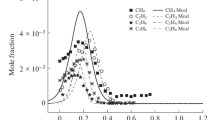Abstract
This paper gives results of numerical modeling of a laminar hydrogen—oxygen flame doped with trimethyl phosphate at various pressures and compositions of the combustible mixture. The calculations were performed using the PREMIX and CHEMKIN-II software packages. It was found that phosphorus-containing additives promoted the flame at subatmospheric pressures and inhibited it at atmospheric pressure. Kinetic analysis showed that catalytic recombination reactions were responsible for both phenomena. In the case of subatmospheric pressures, the promoting effect and its enhancement with increasing additive concentration were related to a flame temperature rise in the chemical-reaction zone due to catalysis of the recombination reactions by phosphorus-containing compounds. Increasing the additive concentration led to an increase in both the rate of the branching reaction H + O2 = OH + O and the rate of the chain termination reaction, but the increase in branching reaction rate prevails, resulting in an increase in the flame velocity. In the case of atmospheric-pressure flames, where the reaction-zone temperature is close to the adiabatic equilibrium value, the additive led to an increase in the rate of decay of active flame species and, hence, to a decrease in the flame propagation velocity with increasing additive concentration.
Similar content being viewed by others
References
J. Warnatz, “Calculation of the structure of laminar flat flames II: Flame velocity of freely propagating hydrogen-air and hydrogen-oxygen flames,” Ber. Bunsenges. Phys. Chem., 82, 643 (1978).
C. M. Vagelopoulos, F. N. Egolfopoulos, and C. K. Law, “Further considerations on the determination of laminar flame velocities with the counterflow twin flame technique,” in: Twenty-Fifth Symp. (Int.) on Combustion, Combustion Inst., Pittsburgh, PA (1994), p. 1341.
F. N. Egolfopoulos and C. K. Law, “A kinetic criterion of flammability limits: the CHO-inert system,” in: Twenty-Third Symp. (Int.) on Combustion, Combustion Inst., Pittsburgh (1990), p. 333.
N. J. Brown, K. H. Eberius, R. M. Fristrom, et al., “Low pressure hydrogen-oxygen flame studies,” Combust. Flame, 33, 151 (1978).
G. Dixon-Lewis, M. M. Sutton, and A. Willams, “Flame structure and flame reaction kinetic. VII. Structure, properties, and mechanism of a rich hydrogen + nitrogen + oxygen flame at low pressure,” Proc. Roy. Soc, Ser. A, 317, 227–234 (1970).
J. Vandooren and J. Bian, “Validation of H2/O2 reaction mechanisms by comparison with the experimental structure of a rich hydrogen-oxygen flame,” in: Twenty-Third Symp. (Int.) on Combustion, The Combustion Inst., Pittsburgh (1990), p. 839.
O. P. Korobeinichev, V. M. Shvartsberg, S. B. Il’yin, et al., “Laminar flame structure in a low-pressure premixed H2/O2/Ar mixture,” Combust., Expl., Shock Waves, 35, No. 3, 239–244 (1999).
J. Warnatz, Combustion Chemistry, Springer, New York (1984).
J. W. Hastie and D. W. Bonnell, “Molecular chemistry of inhibited combustion systems,” National Bureau of Standards, Report No. NBSIR 80-2169 (1980).
A. J. Twarowski, “The temperature dependence of H + OH recombination in phosphorus oxide containing combustion gases,” Combust. Flame, 105, 407–413 (1996).
O. P. Korobeinichev, S. B. Ilyin, T. A. Bolshova, et al., “The chemistry of the destruction of organophosphorus compounds in flames — III: The destruction of DMMP and TMP in a flame of hydrogen and oxygen,” Combust. Flame, 121, 593–609 (2000).
O. P. Korobeinichev, T. A. Bolshova, V. M. Shvartsberg, and A. A. Chernov, “Inhibition and promotion of combustion by organophosphorus compounds added to flames of CH4 or H2 + O2 and Ar,” Combust. Flame, 125, 744 (2001).
J. H. Werner and T. A. Cool, “A kinetic model for decomposition of dmmp in a hydrogen/oxygen flame,” Combust. Flame, 117, 78 (1999).
http://www-cms.llnl.gov/combustion/organophos_c3_30c_therm.txt.
P. A. Glaude, C. Melius, W. J. Pitz, and C. K. Westbrook, “Detailed chemical kinetic reaction mechanisms for incineration of organophosphorus and fluoro-organophosphorus compounds,” Proc. Combust. Inst., 29, 2469–2476 (2002).
O. P. Korobeinichev, V. M. Shvartsberg, A. G. Shmakov, et al., “Flame inhibition by phosphorus-containing compounds in lean and rich propane flames,” Proc. Combust. Inst., 30, No. 2, 2353–2360 (2004).
N. L. Haworth, G. B. Bacskay, and J. C. Mackie, “The role of phosphorus dioxide in the H + OH recombination reaction: Ab initio quantum chemical computation of thermochemical and rate parameters,” J. Phys. Chem., A, 106, No. 8, 1533–1541 (2002).
V. S. Babkin and A. V. V’yun, “Inhibition of hydrogen-air flame at high pressures,” Combust., Expl., Shock Waves, 17, No, 5, 483–488 (1981).
R. J. Kee, J. F. Grcar, M. D. Smooke, and J. A. Miller, “PREMIX,” Sandia National Laboratories, Report No. SAND 85-8240.
R. J. Kee, F. M. Rupley, and J. A. Miller, “CHEMKIN-II: A Fortran chemical kinetics package for the analysis of gas phase chemical kinetics,” Sandia National Laboratories, Report No. SAND 89-8009B.
O. P. Korobeinichev, V. M. Shvartsberg, and A. A. Chernov, “The destruction chemistry of organophosphorus compounds in flames — II: Structure of hydrogen-oxygen flame doped with trimethyl phosphate,” Combust. Flame, 118, 727–732 (1999).
M. R. Zachariah and O. I. Smith, “Sulfur chemistry in H2/O2/SO2 flames,” Combust. Flame, 69, 125–139 (1987).
V. N. Strokin and V. M. Khailov, “Effects of nitric oxide on the ignition delay of hydrogen in air,” Combust., Expl., Shock Waves, 10, No. 2, 198–201 (1974).
Author information
Authors and Affiliations
Additional information
__________
Translated from Fizika Goreniya i Vzryva, Vol. 42, No. 5, pp. 3–13, September–October, 2006.
Rights and permissions
About this article
Cite this article
Bolshova, T.A., Korobeinichev, O.P. Promotion and inhibition of a hydrogen—oxygen flame by the addition of trimethyl phosphate. Combust Explos Shock Waves 42, 493–502 (2006). https://doi.org/10.1007/s10573-006-0081-z
Received:
Revised:
Issue Date:
DOI: https://doi.org/10.1007/s10573-006-0081-z




